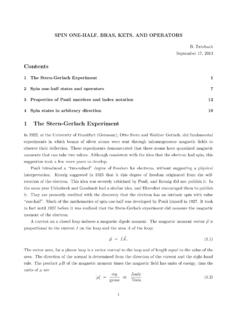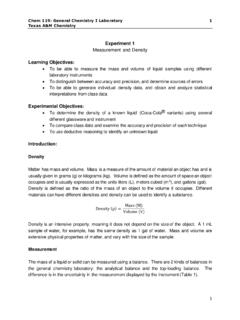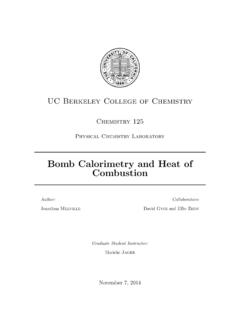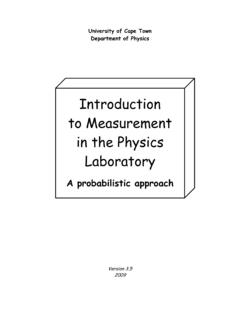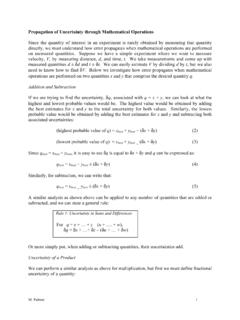Transcription of Experiment 1 (Lab period 1) Spectrophotometry: Absorption ...
1 Experiment 1 (Lab period 1) Spectrophotometry: Absorption spectra and the use of light Absorption to measure concentration Spectrophotometry is a procedure that is frequently utilized in biological laboratories. Probably the most common application in biology of this technique is in the measurement of the concentration of a compound in solution. In this lab you will be introduced to the concepts of spectrophotometry as well as how it is used to measure the concentration of compunds in solution. Over the rest of the course you will apply spectrophotometry on several occasions. Spectrophotometry is the measurement of the interaction of light with matter. Many kinds of biological substances absorb visible light (400 to 700 nm) selectively and, as a result, appear colored. Substances that do absorb visible light are called pigments. Other substances do not absorb light of visible wavelengths and appear colorless. We can study colorless compounds in two different ways. One is that they can often react with other substances to form colored derivatives that we can see and measure (as you will see later on in this course).
2 Another is that colorless compounds usually absorb light in the region of the spectrum that is not visible to the naked eye. Absorption of this light can be measured, even if we cannot observe it unaided. Using a spectrophotometer, which measures the Absorption by a solution of light of specific wavelengths (visible or not), allows us to determine concentration as discussed below. A second application of spectrophotomerty is the determination of the Absorption spectrum of a compound. (Both of these can be applied to colorless as well as colored solutions since a spectrophotometer can measure absorbance of light that we cannot see.) These two applications are discussed separately below. Absorption spectra and color Regardless of whether a solution is colorless or colored, the wavelength(s) absorbed are distinctive. A solution of a particular compound, such as hemoglobin, always absorbs light of specific wavelengths and reflects light of other wavelengths. Furthermore, Absorption of light is not absolute.
3 A compound will characteristically absorb a certain proportion, anywhere from 0% to 100%, of light of a specific wavelength. For every compound, if you measure the proportion of light absorbed, for any wavelength, you will always get the same answer. This is the basic idea of the Absorption spectrum of a specific compound, which is the proportion of light absorbed for each wavelength of the spectrum. The wavelength(s) absorbed by a substance in the visible part of the spectrum is complementary to the color that we perceive. The "color" is a function of human perception, but Absorption of specific wavelengths of light is a function of molecular interaction with light. If a substance absorbs blue and red light, but not green light, we will see it as green since that is the only light that reaches us from that substance. Therefore, when you look at the Absorption spectrum of a green solution, it should show low absorbance of wavelengths in the green part of the spectrum but high Absorption of light in the red and blue parts of the visible spectrum.
4 While the "color" of a substance depends on the person observing it, Absorption of specific wavelengths depends on the molecular structure of the substance. This allows qualitative analysis ( , identification) of some substances by determination of the Absorption spectrum. In this lab you will determine the Absorption spectrum of a red pigment, hemoglobin. Measuring concentration The basis of this application of spectrophotometry is that the proportion of light that is absorbed by a solution of a particular compound is a function of the concentration of that compound. This allows for a quantitative analysis of concentration of a substance from the Beer-Lambert relationship (below). A spectrophotometer will direct light of a specific wavelength on your solution. This light is the incident light. The light that passes through the solution is the transmitted light. The absorbance (A) of the solution is the log of the ratio of these two measures: A (Absorbance, or Optical Density) = log10 (Intensity of incident light / Intensity of transmitted light) The spectrophotometer will calculate and display the absorbance.
5 Once we know the absorbance, concentration of the solution follows from the Beer-Lambert equation: A = E * C * L in which: E (Molar Absorption ) = absorbance of a l M solution of the substance measured through a l-cm light path. This is a constant for the substance at a given wavelength. C = concentration, in moles/liter. L = length of the light path through the solution, in cm. For the spectrophotometer we will be using, L is equal to 1 cm. Therefore, since L equals 1, C = A / E. In order to apply the Beer-Lambert equation you must know the Molar Absorption Value (E) for the substance (compound) and wavelength you are using. This is defined as the Absorbance of a 1 M solution so it can be measured easily by the obvious - reading Absorbance of a 1 M solution. However, for substances with strong absorbance, the Absorbance of a l M solution is too great to read in an analytical instrument. In this case a standard curve is produced by measuring Absorbance of a number of dilute solutions, each of known concentration.
6 When Absorbance is plotted against concentration the slope of the line is the relationship between concentration and Absorbance. This is the E value (E=A/C, if L=1) so the slope of the standard curve gives you E. Once you have measured E, you can find the concentration of any solution (of that compound) by measuring Absorbance at the same wavelength used to calculate E. In this lab, you will examine both of these aspects of spectrophotometry. First, you will determine the Absorption spectrum of hemoglobin by measuring the absorbance of light of different wavelengths. Second, you will construct a standard curve for protein serum and calculate E for this compound. Then, using this value you will determine the concentration of various dilutions of a serum solution and then calculate the concentration of the serum solution. The analytical instrument you will use is a spectrophotometer. As mentioned above, a spectrophotometer measures the intensity of light transmitted through a solution.
7 It consists of two principal parts: a spectrometer and a photometer. Using a white light source and a monochromator (a prism), the spectrometer of the instrument is designed to provide discrete wavelengths of light at a known intensity. The photometer consists of a photoelectric tube sensitive to the wavelengths of light provided by the spectrometer and a galvanometer to quantitate the intensity of the light. The sample to be measured is inserted between the spectrometer and the photometer. By comparing the intensity emitted by the spectrometer to the intensity measured by the photometer, absorbance by the solution can be calculated by the machine. Procedure A - Absorption SPECTRUM OF HEMOGLOBIN Almost all of the oxygen carried in the blood is combined with hemoglobin within the red blood cells. Hemoglobin is composed of a protein (globin) to which the red, iron-containing heme molecule is attached. The Absorption spectrum of hemoglobin in the visible range is characteristic of many heme-containing proteins.
8 L. Prepare and label two cuvettes: Cuvette l containing 4 ml distilled water Cuvette 2 containing 4 ml blood diluted in distilled water Cuvette l is the reference cuvette, or blank; cuvette 2 is the sample cuvette. The reference cuvette is used to Zero the spectrophotometer. This means that you adjust the Absorbance reading to zero while the reference is in the spectrophotometer. As a result, when you put your sample into the spectorphotometer, the Absorbance measures only Absorption by the compound in solution, not Absorption by the solvent (see Appendix 1 on operating the Spectrophotometer). 2. Read the Absorbance of the sample of diluted blood every l0 nm from 400 to 700 nm. Wherever Absorbance rises significantly, read at 5 nm intervals. Record your data in your notebook. 3. Place a strip of white paper in a cuvette and place the cuvette in the sample holder. Leaving the cover open, rotate the wavelength control slowly from 650 nm to 400 nm. Record the wavelengths at which the color of the incident light clearly changes color; you should see a spectrum from dark red light to pale violet.
9 B - BIURET COLORIMETRIC ASSAY OF SERUM PROTEIN Proteins react with copper ions in alkaline solution to form a violet-colored complex that absorbs light at 550 nm. This reaction is the basis of the biuret assay for protein. Biuret reagent is a solution of CuSO4 in NaOH. When you add biuret reagent to a protein solution the reaction produces a solution of the protein-biuret complex in a concentration that is the same as the original concentration of protein. Therefore, by measuring the concentration of the complex, using A550 (Absorbance at 550 nm), you are also measuring the concentration of protein. The assay consists of two parts that will be conducted simultaneously. The first part consists of establishing a standard curve by using several known quantities of a pure protein. In this Experiment bovine serum albumin (BSA) will be used as the protein to be reacted with the biuret reagent. Since all proteins react with the biuret agent in the same manner, this standard curve will give us an E value that can be applied to any protein solution reacted with biuret.
10 The second part consists of reacting measured quantities of serum (protein) with the biuret reagent and measuring the Absorbance of each reaction mixture. l. Prepare and label eleven test tubes as shown in the table. Use one l-ml pipet to dispense the NaCl solution to all tubes, then a second l-ml pipet to dispense the BSA solution, and a third l-ml pipet to dispense the serum. Standard curve Serum measurement Tube Volume of NaCl (ml) Volume of 10mg/ml BSA (ml) Tube Volume of NaCl (ml) Volume of serum sample 1(Blank) 0 1a 2 2a 3 3a 4 4a 5 6 7 0 2. When the eleven tubes have been prepared, mix the contents of each tube well by closing the tube with Parafilm and inverting the tube. Then, using the pipet pump (do not mouth- pipet biuret reagent) add 4 ml of biuret reagent to each tube and mix well again. 3. Allow the protein to react with the reagent for 30 min. 4. Read the Absorbance of each mixture at 550 nm.










